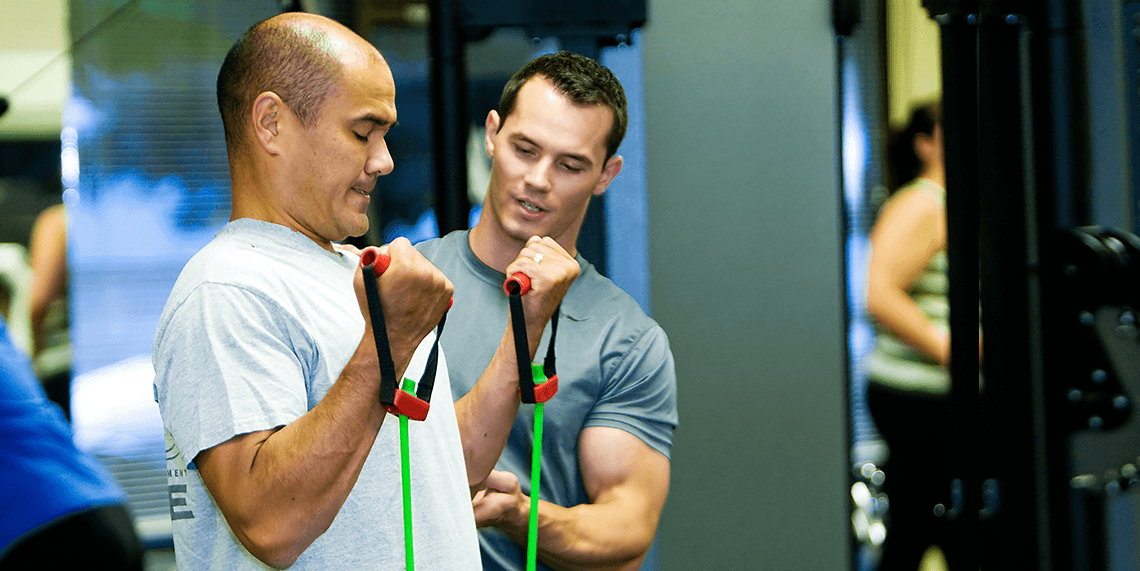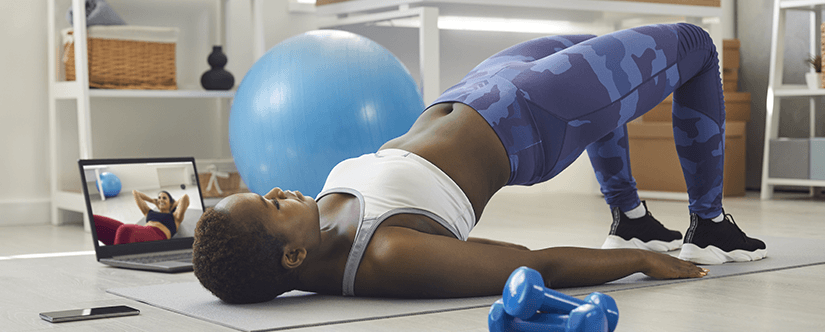If you struggle with personal training program design for beginner clients, you're not alone. Most of us have spent years working out in the gym, and it can be tough to develop a program for a total beginner. When we give clients too much too soon, they can feel overwhelmed and tempted to give up.
We need to recognize the importance of putting ourselves in a brand-new client's shoes. Not only are they unsure of what to expect, but they're also likely nervous, afraid of failing, and apprehensive about feeling judged. It's important that we give our clients some small wins right off the bat, helping to grow their confidence and keep them moving in the right direction.
In the first few weeks of working with a personal trainer, clients will decide whether they're going to buy into the program or start looking for something else. This "make or break" period is vital for ensuring that clients will decide to commit to your program (and stick with you after the program ends). It's key to find a balance of providing clients with both challenges and successes that will keep them motivated to go the distance with your program.
If you're feeling overwhelmed by developing a program for beginner clients, no worries—our Focus System has you covered. Here, we'll lay out a straightforward formula you can use to create a top-notch beginner workout program in less than half an hour.
Let's get started.
Focus System Step 1: Choose a rep range
Identifying rep range is the key to simplifying personal training program design. Once you identify it, everything else—including sets, tempo, and rest—follows.
Determining rep range starts with understanding the client's goals. If your client wants to train for power, they'll be in rep range 1 to 5. If they want to train for muscle endurance, they'll be in rep range 12 to 15, and so on. The higher your client's rep range, the lower their sets will be. For example, a client who is training for power will do more sets with fewer reps, while a client who is training for muscle endurance will do fewer sets with more reps.
The rep range also determines the number of exercises that a client will be able to complete throughout their workout. If a client is doing power or maximal strength exercises with a lower rep range, they'll be completing fewer sets over the course of the workout, meaning they'll have a lower number of unique exercises than someone who is training for muscle endurance. If clients are working on muscular endurance, it's less important to focus on perfect form, meaning there's a bit more wiggle room for beginning clients to get the hang of new exercises.
In addition to the number of sets and exercise variety, rep range will also determine the types of exercises you'll include in the program. If a client is working to build power, you'll focus on power exercises like Romanian deadlifts or squat variations. While some clients may require power training on isolated muscle groups, most beginner clients will not require this level of specificity.
Your client's rep range will also determine the tempo of each exercise. There are many different tempos that can be useful for muscle endurance, including a 4-2-1 tempo (4-second eccentric contraction, 2-second pause, 1-second concentric contraction). Taking a moment or two to pause while the muscle is under tension increases the stress on the muscle and can be a great way to give the client a small extra push. For power clients, you may want to use a 1-0-1 tempo. For hypertrophy (muscle growth) workouts, you'll likely want to stick with a 3-0-1 tempo.
The final variable you'll need to determine in your beginner client's workout program is their rest intervals. The goal is to train the client efficiently, allowing them sufficient time to rest between sets. Power clients will require 2 to 3 minutes of rest between each set to fully replenish the creatine phosphate system. Muscle endurance clients need shorter rest intervals—a minute and a half is usually more than enough time for recovery between sets.
Focus System Step 2: Select your primary exercises
After you've determined the appropriate rep range for your client, it's time to dig into their primary exercises. It's important to choose these carefully—clients will get most of their gains from these exercises, and you'll use their performance in these sets to determine their progress. You'll want to track all weights, sets, and reps at each workout to ensure that your client is making progress (and of course, you can make adjustments as necessary).
If you're just getting started with personal training program design, it can take some time to choose primary exercises. Over time, you'll find that the process becomes more intuitive. In order to choose the primary exercises for beginner clients, I’d complete a body-type analysis, consider the client's goals, and from there, choose the exercises most important for their forward progress. I usually stick with multijoint movements, including squats, deadlifts, chest presses, rows, and lunges.
When a client is just starting out, they can't master more than two to four exercises at a time. Taking it slow allows clients to slowly build their skill base, growing their confidence one rep at a time. When describing a program to a client, it's a lot easier to sell them on a handful of highly beneficial exercises than a laundry list of complicated moves. Remember, your client probably has never lived the gym rat life—you don't need to show off your in-depth knowledge to get them the results they want.
Here's what primary exercises might look like in an effective beginner workout program:
- In a workout focused on developing muscular endurance in the 12-to-15-rep range, the two primary exercises might be the sumo squat and the alternating biceps curl to overhead press.
- In a workout focused on developing power in the 1-to-5-rep range, the exercises might be the deadlift and a barbell clean.
Focus System Step 3: Select your secondary exercises
Programmed as circuits or supersets, secondary exercises allow you to support primary movements and help your client continue to make progress. You can have more flexibility and fun with secondary movements than with primary movements. Form is still key, as always, but you won't need to be as much of a stickler as with primary movements. By the time you get to secondary exercises, your client's energy will begin to dip.
Remember, while you can vary exercises greatly here, the goal is still to support primary movements. Single-joint movements are a good fit in this step, as are core and single-leg movements.
Here's what secondary exercises might look like in a beginner program design:
- In a muscle endurance workout where primary exercises are sumo squat and alternating biceps curl to overhead press, secondary exercises might be a single-leg deadlift and triceps kickbacks.
- In a power workout where the primary exercises are a deadlift and barbell clean, secondary exercises might be single-leg glute bridges and single-leg squats.
Focus System Step 4: Select your tertiary exercises
Tertiary exercises can be both prehabilitative and rehabilitative. These movements can fit into active rest between sets or can follow the secondary exercises (if time permits).
Rehab and prehab exercises are designed to correct muscle imbalances or address injuries. Some clients may not have time for prehab exercises, as their rehabilitative needs are too great. All levels of clients can use prehab and rehab exercises, and these movements will not change based on the type of workout a client is doing. Both power and muscular endurance clients will use the same types of prehab and rehab exercises to correct imbalances and heal injuries.
Focus System Step 5: Choose a cardio option
I'm not a big fan of cardio exercise, but there's a time and place where it makes sense for clients. Usually, cardio can be included in a program by paying attention to rest intervals in between resistance sets.
Steady-state cardio, however, can have major benefits for mental health and stress management. When a client's mind is in the right place, it's easier to stay on track with the behaviors that will bring them closer to their goals. Half an hour on the treadmill or the elliptical can burn calories while also helping a client get into the right headspace to stay on track.
Don't forget—if you aren't careful, cardio can hurt client progress. If your client is working toward muscle growth, steady-state cardio isn't a good idea. For muscular endurance clients, however, some steady-state cardio isn't going to stop them from hitting their goals.
Here's what a cardio protocol might look like for a beginner:
- For a muscle endurance client, a hybrid cardio protocol that includes both steady-state and interval training may be a good fit.
- For a power client, two days of high-intensity interval training per week may allow them to grow their cardio fitness without negatively affecting their power gains.
Focus System Step 6: Create a warmup routine
When creating a warmup routine for your beginner client, you'll want to consider how comfortable they feel in the gym. Keeping it simple is smart. You'll also want to think about the rest of the workout and ensure that you're preparing their body for the movements they'll do in their program.
All clients should go through myofascial release before the start of their workout to help boost their movement efficiency. Clients focusing on muscular endurance will need more movement prep work, while power clients will focus on mobility drills and dynamic stretches. You may also choose to have your clients perform myofascial release at the end of their workout.
An important note about beginner clients: It's likely that they'll need your encouragement to complete their warmup. Don't trust clients to warm up on their own when they're just getting started. During the initial phases of getting to know a beginner client, the warmup can give you some time to get to know them and better understand their roadblocks and motivation.
As your client progresses, you can let them know that you'd like them to complete their warmup before the start of your training time. This allows more time for you and your client to work together on the moves that will bring them closer to their goals.
The Focus System in action
The following personal training program was designed for an imaginary client—someone who is starting at an intermediate level and has no injuries but struggles with posture due to spending much of their time driving or in front of a computer screen. The client wants to improve their core strength and lose fat.
This example is not meant to be used as a guide to show you which exercises to include in your personal training program designs. Rather, it's meant to show you how the Focus System works.
Day 1 (full-body push)
1. Squat (primary) 4*8-10 superset with scapular wall slides (tertiary)
2. Curl to overhead press (primary) 4*8-10 superset with corner wall stretch (tertiary)
3. Speed interval 1.5min at 80-95%MHR
4a. Wide pushup (secondary) 2*15-20
4b. Plank with reach (secondary) 2*5 superset ball lat stretch (tertiary)
5. Speed interval 1.5min at 80-95%MHR
6a. Split squat (rear foot elevated) (secondary) 2* 10-12
6b. Alternating lunge (secondary) 2*6-8
7. Front raise (tertiary) 2*8-10
Day 2 (full body pull)
1. Romanian Deadlift (primary) 4*8-10 superset band walks (tertiary)
2. Chin-up (primary) 4*8-10 superset sleeper stretch (tertiary)
3. Speed interval 1.5min at 80-95%MHR
4a. Single-leg glute raise 2*6-8 (secondary)
4b. Ball plank with knee pull 2*12-15 (secondary)
5. Speed interval 1.5min at 80-95%MHR
6a. Reverse fly 2*8-10 (secondary)
6b. Kettlebell swing 2*6-8 (secondary)
7. Russian twist 2*12-15
Cardio guidelines – 2 sessions per week. One day complete a 30-minute jog or elliptical training session at 70-80%MHR. On the second day, complete 60-second speed intervals at a 6:1 rest-to-work ratio.
Note: 4*8-10 denotes 4 sets of 8-10 reps. If I have a “1” before the exercise, then all sets are to be completed before moving on to the next exercise. For example, I have a 1a and 1b so the exercises are meant to be done in a superset.
Breaking it down
Step 1: Rep range
Remember, the rep range determines most of the other variables in personal training program design. The client's goal is fat loss, so the client needs to build some muscle. This workout becomes more metabolic as the client works through the secondary exercises. Reps increase and speed intervals help keep the client's heart rate up throughout the workout.
Step 2: Primary exercises
For this client's primary exercises, I wanted to use large, multijoint exercises—not power movements. I also wanted to give this client full-body workouts during both training sessions, so I divided the workouts into push and pull sessions. Four primary exercises are an appropriate amount for an intermediate client. For a beginning client, I'd stick to two primary exercises.
Step 3: Secondary exercises
Here, I added some variation to the workout, working muscles that would benefit the client's primary exercises. I also added some core strength exercises (plank with reach, ball plank with knee pull, Russian twist) to this component.
Step 4: Tertiary exercises
In this program, I included tertiary exercises between sets, rather than adding them at the end of the workout. This intermediate client is likely to have performed many of these movements before. Since the client's goal is fat loss, I wanted the workout to be metabolic, and keeping the client moving with active rest will help them reach their goals more quickly.
Step 5: Cardio guidelines
A combination of steady-state cardio and interval training (both as a part of the client's cardio guidelines) will help the client work toward fat loss.
Step 6: Dynamic warmup
Remember, this program design is for an intermediate client—it's not an effective beginner workout program. This means that this client would likely be comfortable performing the warmup by themself. I would show the client the warmup once, give them a handout detailing each move, and trust that they’d complete the warmup before the start of each session.
Don't overwhelm your client
The experience of joining a gym and/or working with a trainer can be overwhelming to someone who’s just getting started. When you create a complicated program, you're setting your beginner client up to fail.
With the Focus System, we want to “focus” on one or two aspects of the client’s program.
Get your client small wins, talk to them about their early strength gains, and let them know about a couple of exercises included in their program that are going to help them meet their goals.
Don't overdo it—give your client the information that will benefit them most, and keep the rest to yourself. Follow the Focus System, ease your beginner clients into their new routine, and remember—your client isn't interested in all the details of their program design. They'll see your expertise speak for itself as their results begin to come through.














